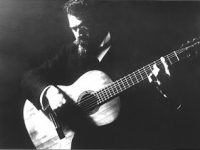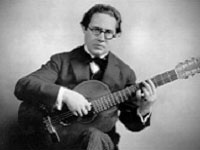Classical Guitar Strap
Curious to see what was possible for classical guitarists who want to play standing up, I Googled “classical guitar strap” and came up with this interesting item:
















Curious to see what was possible for classical guitarists who want to play standing up, I Googled “classical guitar strap” and came up with this interesting item:
Played by Regina Albanez. This is a great favorite among classical guitarists. Many of them make it sound pretty good on a classical guitar (check Bream and Williams), but just listen to the charm of the piece played on the instrument it was written for, the baroque guitar.
Jose Feliciano and friends just having a great time.
Usually.
Fret Killer, the All-American guitar player, is back. He was off YouTube for a long time. His previous YouTube channel was removed by YouTube for copyright issues, I’m guessing.
Although I can make a guess, I don’t know for sure who Fretkillr is. (And If I knew, I wouldn’t say, because it’s clear he wants to remain anonymous.) He never shows his face. He plays steel-string, 12-string, country, blues, oldies, Broadway, flat-picking, finger-picking, Scottish fiddle tunes and I don’t know what else. He had over a hundred videos up on YouTube at one time and many of them were gems. His new YouTube channel is called FretKillrLives.
I think he must be an old pro who’s played with everyone, but I can’t say for sure. Maybe he’s sitting in San Quentin waiting for a train. But he’s someone most Americans would recognize immediately as “a real guitar player.” I think he’s great.
From Wikipedia:
“The Wayfaring Stranger” (aka “Poor Wayfaring Stranger” or “I Am a Poor Wayfaring Stranger”), is a well-known British spiritual/folk song originating in the early 18th century about a plaintive soul on the journey through life. It became one of Burl Ives’s signature songs, included on his 1944 album The Wayfaring Stranger. Ives used it as the title of his early 1940s CBS radio show and his 1948 autobiography. He became known as “The Wayfaring Stranger.”
As with many folk songs, the words are often changed. “While travelin’ through this world below” has also been sung “this world of woe” and “this world alone.”
Milos Karadaglic, in case you haven’t heard, is the hot new guitar player this year. By “hot,” I mean in the showbiz sense. Boffo. Big bank.
For one thing, he’s got Deutsche Grammophon behind him. It doesn’t get more prestigious than that. Milos signed with DG last summer. They’re sending him all over the world to promote his debut album with DG, Mediterraneo.
And I don’t mind helping them out a little. Milos is a good player. (Yes, I call him just “Milos.” I can’t seem to remember “Karadaglic” very well. I notice that DG, too, has started calling him just “Milos” in their publicity. Good move.)
Milos is getting tremendous publicity. I first noticed the publicity campaign a few months ago when a well-written article about the guitarist came out in The Economist magazine, of all places.
Then I heard there was a TV commercial for his new recording on CBS TV. When’s the last time you saw a classical guitarist advertised on national network TV? Never. This is quite a push.
So I Googled around and he’s everywhere. Then I looked on YouTube to see what all the fuss is about. There I found video after video put out by Deutsche Grammophon pushing their new guitar star, but the videos were mostly hype. Lots of high-end, glamorous hype.
Which is perfectly understandable and acceptable, except I didn’t want to blog any of it. I wanted an honest, well-presented, and complete live performance – something that might be representative of what Milos is really about.
Yesterday I found one that wasn’t put out by DG. Although it’s mistitled – it says the piece is Granada by Albeniz – it’s still a nice video. It’s actually Milos playing Danza Espanola No. 5 by Granados, a great favorite with classical guitarists. It’s the fifth of the famous Twelve Spanish Dances for piano by Granados, published in 1890. The piece’s individual name is Andaluza, or sometimes it’s called Playera. (I don’t know why it has so many names.)
I heard a quote from Milos today: “I want people to fall in love with the guitar.”
I’ll second that. You’re doing a good job, Milos.
Ariana Burstein, ‘cello, and Roberto Legnani, guitar, perform the Danza Espagnola No.2, opus 37 – “Oriental.” Originally for piano solo by the great Spanish composer Enrique Granados, this piece is very popular with guitarists as a guitar duet. Bream & Williams and Presti & Lagoya, for example, recorded beautiful versions of it.
It is also sometimes heard arranged for guitar solo. It’s on the new recording by Milos Karadaglic, Mediterraneo.
(And contrary to the publicity materials for this recording, it is not the “first time ever” that it has been arranged for solo guitar. Denian Arcoleo does a beautiful job of it, as you will see and hear in the second video. Another fine arrangement exists by Jose Luis Gonzalez.)
But this is the first time I’ve heard it for guitar and ‘cello.
Well, I can’t resist. I have to add one more. Here it is by this wonderful couple, Evangelos and Liza, about whom Segovia said:
“Since fate cruelly deprived us of Presti and Lagoya, I no longer had the pleasure of listening to any comparable duet. But lately, when the talented Greek guitarists Evangelos and Liza played for me, I felt total satisfaction and enjoyment. They have rhythm, good taste, emotion and technique. They work together with loyalty to the music and vital dedication. I cordially wish Evangelos and Liza to conquer the high estimation of the public as they have conquered mine.”
Hilary has a great way of just letting music speak for itself.
“The guitar speaks directly to the heart, with quiet simplicity.” -Segovia
A popular and ancient Irish air.
A little history from Ceolas.org:
“The Queen of Irish Airs” maintains Francis O’Neill (1913). There are many versions of this ancient and celebrated air “of which Bunting’s and Moore’s are not among the best: they are both wanting in simplicity,” states Joyce (1909), who prints the tune as collected by Forde from Hugh O’Beirne (a Munster fiddler from whom a great many tunes were collected). He considers Forde’s version “beautiful…(and) probably the original unadulterated melody,” and adds that it is similar to the version he heard the old Limerick people sing in his youth during the 1820’s. Flood (1906) states it is probable the air dates from the year 1296 or 1297, believing it must have been composed not long after the Statute, 24th of Edward I, in 1295, which forbade those English in Ireland (who were becoming assimilated into the majority Gaelic culture) to affect the Irish hair style by allowing their locks to grow in “coolins.”
The original song, told from a young maiden’s point of view, berates those Anglo-Irish who conformed to the edict by cutting their hair, and praises the proud Irishman who remained true to ancestral custom (the Gaelic title “An Chuilfhionn,” means ‘the fair-haired one’).
The Irish Parliament passed another law in 1539 forbidding any male, Irish or Anglo-Irish, from wearing long or flowing locks of hair.
This piece was made even more popular in the 1990s by Michael Flatley (of Riverdance and Lord of the Dance fame). He called his arrangement Whispering Wind. Here it is as a concert solo in 1998 in Hyde Park, in the perfect moment of a summer twilight as the last traces of blue fade from the sky.
Koshkin’s cycle of preludes and fugues continues to emerge…